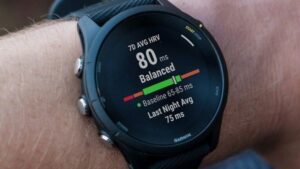HRV: The Executive Brief On All Things HRV
HRV has been a massive topic of discussion with my clients over the past month. There have been many questions about what it is and if it’s essential or not. I wrote an article using the simplest terms possible because it is a critical measure of your recovery and health.
What is HRV?
HRV, or Heart Rate Variability, refers to the variation in time between consecutive heartbeats.
We are taught to believe the heart beats perfectly like a metronome when, in reality, a healthy heart doesn’t beat at regular intervals. There are minor variances in each beat.
For example, if your heart rate is 60 beats per minute, it doesn’t mean your heart beats precisely once every second. Instead, there might be slight variations, such as 0.9 seconds between two beats and 1.1 seconds between the next. So HRV is the measure of that variability in milliseconds.

Why HRV Matters
HRV is an important indicator of your autonomic nervous system (ANS) health, which manages your body’s stress response and recovery. The ANS has two main branches:
- Sympathetic Nervous System (SNS): This is fight-or-flight. It’s active when we are stressed out, getting ready to play a game, kids screaming, training hard, in cold water, hammered drunk, high as hell on Delta-9, etc.
- Parasympathetic Nervous System (PNS): This is rest and digest. It slows the heart rate and aids recovery and relaxation. It’s yoga, massage, meditation, post-high-stress sleep, etc.
A high HRV IS GOOD!!! A high HRV indicates that your body has a strong and responsive autonomic nervous system (ANS), which can efficiently switch between stress and recovery modes. A high HRV suggests you are well-rested, resilient, and capable of effectively handling stress or physical exertion.
A low HRV is BAD!!! Conversely, a low HRV implies that your body may be stressed, tired, or experiencing poor recovery. It means your nervous system is less adaptable, potentially due to stress, illness, overtraining, or insufficient rest.
HRV as a Measure of Recovery
HRV is commonly used as a recovery metric because it provides insights into how well your body is coping with stress and recovering from physical or mental exertion:
- High HRV indicates that your body is well-recovered and ready for more intense activity.
- Low HRV suggests that your body is under stress, whether from physical exertion, emotional challenges, or lack of sleep. Low HRV can indicate that you need more rest or a lighter activity load to promote recovery.
HRV is a simple yet powerful way to gauge your readiness and overall balance between stress and recovery. By tracking HRV we can adjust training, recovery, and lifestyle choices to optimize performance and well-being.
HRV Can Predict Sickness
Heart Rate Variability (HRV) reflects the state of your autonomic nervous system (ANS), which controls essential functions like heart rate, digestion, and respiratory rate. A significant drop in HRV can indicate that your body is experiencing stress or strain, even before you show physical symptoms of sickness.
Why?
When the body fights off an infection or deals with other stressors, the sympathetic nervous system (the “fight or flight response) tends to dominate. This shift can reduce HRV as the body prioritizes energy for immune response and recovery. As a result, the parasympathetic nervous system (which promotes rest and relaxation) becomes less active, leading to lower variability between heartbeats.

What Is A Good HRV?
Like all measures, HRV is personal and differs based on age and gender. You should track your own HRV to gain an understanding of you, BUT here are some general ranges you should know.
Young, Healthy Adults (49 years old and under): Your HRV should be 60 ms to 120 ms or higher, depending on fitness and lifestyle. Highly fit athletes may even have values above 100 ms.
Healthy Adults 50 and older: HRV tends to decrease with age. A value between 40 ms and 80 ms can still be typical for older individuals.
Elite Athletes: Top-performing athletes have higher HRV values (e.g., above 100 ms) due to their well-conditioned cardiovascular and autonomic systems.
How To Track HRV?
HRV can be tracked through wearables like Garmin, Apple Watch, Fitbit, Whoop or Aura Ring.
Fitbit – Inspire or Versa series track this and show your data on the wearable and in the app.
Apple Watch – The Health app track HRV to view it do the following
- Open the Health app on iPhone.
- Tap the Browse tab in the bottom right corner.
- Now choose Heart> Heart Rate Variability.
Garmin – all the 2020 and newer devices track HRV, Recovery (Body Battery), etc. You can see it on the device or in the Connect app.
Whoop & Aura ring track sleep, recovery, HRV, etc. They charge a monthly fee for access to your data (which you don’t own).



